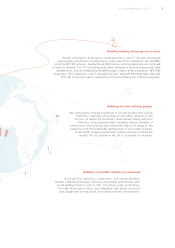Huawei 2014 Annual Report Download - page 21
Download and view the complete annual report
Please find page 21 of the 2014 Huawei annual report below. You can navigate through the pages in the report by either clicking on the pages listed below, or by using the keyword search tool below to find specific information within the annual report.19Management Discussion and Analysis
Focusing on serving carriers' data traffic hubs
and continuously improving solution and service
capabilities
In the mobile broadband domain, we continued to
provide the best user experience to carriers with our
leading products and solutions:
■ Served nine data traffic hubs worldwide.
■ Supported 35 VoLTE networks outside of China, and
helped the South Korean carrier LG Uplus construct
an LTE-A network, which has become the best
practice in the industry.
■ Helped China Mobile, China Telecom, and China
Unicom with LTE construction in all provincial
capitals, and launched the world's largest eMBMS
network for trial commercial use during the 2014
Youth Olympic Games.
■ Worked closely with world-leading carriers on
future-oriented 5G technologies. For example, we
signed an MOU with Etisalat to provide 5G network
assurances for the pavilions during the World Expo
2020.
In the fixed broadband domain, we:
■ Constructed 186 commercial networks worldwide
powered by our 400G core routers in 2014. The
projects involved constructing a new round of ultra-
broadband bearer networks to facilitate 4K video,
LTE-A, and cloud services.
■ Commercially deployed the world's first 1T router
line card through joint innovation with customers,
setting a new record in the industry.
■ Worked with BT to pass the testing for 3 Tbit/s
transmission on live networks.
■ Proposed G.fast technology, which has been made
an industry standard, and released SuperVector
technology, which increased the speed of
existing copper wires threefold and steered speed
acceleration for ultra-broadband copper networks.
Carrier Business
With the rapid development of the ICT industry, the
digital and physical worlds are deeply integrating. A
Better Connected World full of unlimited possibilities is
just around the corner.
Over the past 20-plus years, the ICT industry has
created many growth miracles. ICT infrastructure and
networks play a pivotal role in enhancing national
and industrial prosperity and competitiveness. ICT is
becoming a key enabler for the technological and
business transformations of various industries, as well
as an engine that drives sustainable global development.
ICT has profoundly changed the way people work and
live.
In a Better Connected World, carriers face pressure
from more devices, content, and application scenarios.
To help carriers face these challenges, Huawei focuses
on information transmission, processing, storage, and
presentation. We provide integrated products, services,
and business solutions to help carriers build networks
capable of delivering an optimal experience and cope
with the challenges presented by ICT transformation.
It is Huawei's general strategy to help carriers build
ubiquitous broadband networks that deliver an
optimal experience, operate efficiently, and enable
agile business innovation. To implement this strategy,
Huawei has empowered carriers to develop the key
capabilities required for ICT transformation. They
include building efficient infrastructure, enabling
smart pipes, aggregating digital content, opening up
networks, exploring vertical industries, and conducting
ICT-oriented architecture transformation. We aim to
help carriers bring more value to end users in a Better
Connected World in the future.
























